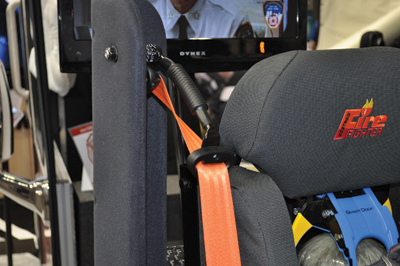By Robert Tutterow
Almost 30,000 people set a record-breaking attendance mark for FDIC this year. Obviously, the poor economy did not hamper firefighters’ quest for knowledge. There was an abundance of learning opportunities ranging from hands-on training to formal presentations to the largest fire exhibition in North America and perhaps the most important-informal networking. This year’s exhibits did not disappoint when it came to safety improvements and innovations in equipment.
Occupant Restraint
First I want to highlight a small item that may have gone unnoticed to many. IMMI, a manufacturer of seat belts and other safety devices for commercial vehicles, introduced the “Ready Reach.” IMMI developed the product in response to firefighter complaints about the difficulty in reaching their shoulder straps in many fire apparatus. Ready Reach is a device that brings the shoulder strap from behind the seat to the side of the seat (photo 1).
 |
| (1) Ready Reach is a device that brings the shoulder strap from behind the seat to the side of the seat. (Photo by author.) |
I highlight this product because it has already been retrofitted to the entire Fire Department of New York (FDNY) fleet. A big salute goes to Lieutenant Mike Wilbur of FDNY for his many years of advocacy for improving seat belt/shoulder strap accessibility. And, salutations also go to FDNY Fire Commissioner Salvatore Cassano for making a “walk the walk” commitment to firefighter safety. If you are one who successfully lobbied your state government for firefighter exemption for wearing seat belts while responding-take note!
Speaking of occupant restraint, Spartan Chassis recently introduced its “Advanced Protection System.” Manufactured by Takata, the system includes huge side curtain air bags, driver and officer knee air bags, outboard sensors for air bag deployment for frontal and side impact, as well as rollover protection. In addition, the seat belt system incorporates retractors that absorb loads.
Safety Components on Apparatus
Hansen International introduced a new LED lighted handrail. With LED lights embedded in the handrail, the lights make the handrails visible, provide lighting for steps and standing surfaces, and improve apparatus visibility. It also introduced a unique compartment roll-up lighting system that allows for user adjustment. And, its new roll-up door steel handle is positioned and enlarged to facilitate opening and closing with a gloved hand.
Class 1 clearly acknowledged that fire apparatus are now in the information age. Its new ES-Key System multiplexing system brings simplicity and safety to apparatus electronics management. The system features one-touch, color-coded, back-lit dimmable switches. It is designed for customization to meet user needs. A few years ago, when we first started to hear about multiplexing, I’m not sure many realized its capabilities.
Contributing to safer apparatus maneuverability, Hale Products introduced its Qmax-XS pump. According to Hale, the XS stands for extra space. With its compact design, the single-stage pump can be installed in a space no wider than 28 inches if electric valves are used (34 inches with manual valves). Yet the XS does not compromise on capacity. It is available in flows from 1,000 to 2,250 gallons per minute (gpm). Its design allows fire departments to specify an apparatus with a shorter wheelbase without compromising other attributes. Or, fire departments can specify additional compartment space without increasing the apparatus height, length, or wheelbase.
From a safety standpoint, it is evident the ambulance industry is gearing up for next year’s release of National Fire Protection Association (NFPA) 1917, Standard for Automotive Ambulances. Yellow antimicrobial hand rails and grab bars are on many units.
For example, Horton Ambulance offers a unit with mini LED light bars placed in the center of the rear red and yellow chevron stripes. Not only did that add to the unit’s visibility but, as one young observer noted, “Dude, that’s just plain cool!”
Safety Evolution in PPE
Globe Manufacturing has developed its Wearable Advanced Sensor Platform (WASP). Designed to be integrated into turnout gear, WASP addresses two areas of need on the emergency scene.
First, it is a firefighter location system that does not rely on GPS or an infrastructure. Second, it performs physiological monitoring. Globe personnel wore WASP at FDIC. The platform will measure heart rate, respiration rate, and heart rate variability. It has a gyroscope to detect the position of the firefighter (standing, crawling, and so on) and an accelerometer for measuring the firefighter’s workload. WASP will be ready for field tests and evaluation later this year.
Mark Mordecai, director of business development for Globe, sees physiological monitoring as the third leg of a three-legged stool, the other two legs being screening and fitness. All three legs are about measurements. One of Edward Deming’s most notable sayings was, “If you can’t measure it, you can’t manage it.” Fireground management is no exception.
ROBERT TUTTEROW retired as safety coordinator for the Charlotte (NC) Fire Department and is a member of the Fire Apparatus & Emergency Equipment editorial advisory board. His 34-year career includes 10 as a volunteer. He has been very active in the National Fire Protection Association through service on the Fire Service Section Executive Board and technical committees involved with safety, apparatus, and personal protective equipment. He is a founding member and president of the Fire Industry Equipment Research Organization (F.I.E.R.O.).

